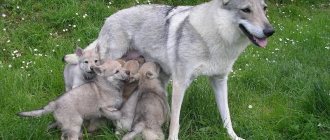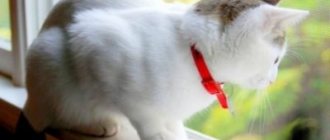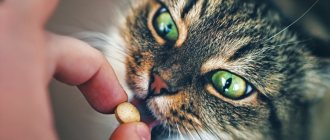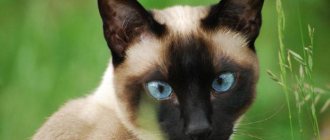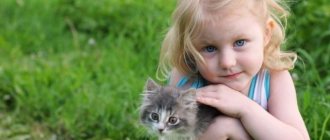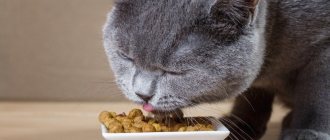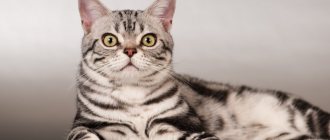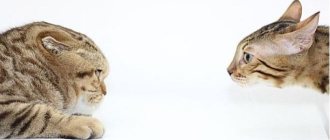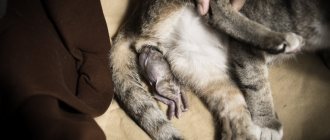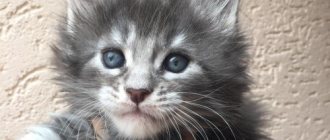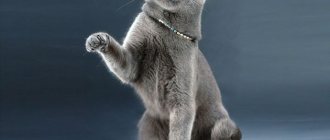Rare breeds of domestic cats
Rare are called cat breeds that are listed in the Red Book and recently bred breeds.
It is known about natural rare breeds and about breeds artificially bred through crossing, about rare wild cats and small breeds living with humans. There are cat breeds that have barely evolved over thousands of years. Unfortunately, the trend is that rare wild cats become extinct over time. They live in their natural environment: jungles and deserts. Outwardly, such animals resemble their domestic relatives. Most likely, over time, there will be no wild rare cats at all, and rare breeds of domestic cats will spread and cease to be small in number.
Munchkins are short-legged cats
One of the rarest cat breeds is the Munchkin.
It is difficult to confuse them with representatives of another breed, since they are characterized by very short legs. The breed is not the result of selection, cats with extremely short legs appeared as a result of mutation. Their second names are “kangaroo cats” and “dachshund cats.” They can sit confidently on their hind legs, using their tail to maintain balance. Munchkins, like dogs, love to walk on a harness. These are gentle, intelligent and sociable cats. They easily find a common language with children, thanks to their equanimity and dog-like devotion.
Serengeti is a breed similar in appearance to the Serval
The rare Serengeti breed was created in 1994 by crossing an Oriental Shorthair and a Bengal cat.
The breeders' goal was to create a pet that would look like an African serval, but without participating in the crossing of this wild breed. Serengetis are intelligent, sociable and loyal cats that love to be part of a family. They don't mind "talking", like Siamese cats. Of all domestic cats, the Serengeti has the longest legs.
Caracal is a wild cat that resembles a lynx
The Caracal is considered one of the rarest cats in the world.
Recently this breed was on the verge of extinction. Outwardly, its representatives resemble a slender lynx, their ears are decorated with long black tassels. The caracal is an inhabitant of the deserts and steppes of the Arabian Peninsula, Africa, Asia Minor and Central Asia, and India. Sometimes it can be found in Southern Turkmenistan and Uzbekistan. This wild breed is easily tamed. In ancient times, they hunted small game with tamed Caracals in Persia and India, but now hunting with such cats is very rare.
The Toyger is one of the new, recently bred cat breeds. They first appeared in India in the eighties of the last century, and the breed standard was approved only in 2003. Outwardly, these cats look like small tigers, but by their nature, pets are ideally suited to living in an apartment. Toygers are unobtrusive, sociable and playful animals.
The Toyger is an ideal domestic cat. There are currently few breeders of this breed. The breed began to actively develop in Australia, America and Canada. This breed is also among the TOP most expensive cats in the world. .
Cat Elf - a cat with crooked ears
The Elf Cat resembles a fantastic creature with crooked ears.
Its body is practically naked or covered with inconspicuous down; sparse hair is present only on the ears, some areas of the legs, on the muzzle and tail. This breed is extremely rare, with a population of only ten people in America. The weight of this active and sociable animal varies from three to six kilograms, and the curvature of the ears can be from ninety to one hundred and eighty degrees.
Ashera is a breed that does not exist
Cats of the Asher breed were sold for several years at incredible prices, and the registration of those wishing to get a kitten was carried out a year in advance.
Ashera was declared as the largest domestic cat, its coloring very reminiscent of a leopard. This breed was developed by Lifestyle Pets. The fact that in reality there is no Asher breed, and that all the hype around this event is just a well-thought-out scam by scammers, became clear several years after the start of active sales of these individuals. The false creator of the Ashera breed at one time purchased kittens of the Savannah breed, after which he carried out a wide advertising campaign and came up with a legend that marked the beginning of hysteria. The deception was made possible due to the fact that Savannah cats themselves are very rare and little known.
Tribute to evolution: what are the differences between a domestic cat and a wild cat?
Contents hide
Tribute to evolution: what are the differences between a domestic cat and a wild cat? Several thousand years ago, a wild cat approached a person’s house, sniffed it, promised protection from harmful rodents, and stayed alive. Has the nature of this animal changed over countless generations? Is there a wild animal living in the domestic cat, or is there nothing left of ancient ancestors left in the creature we stroke on our laps? How wild cats differ from domesticated ones, ilike.pet found out.
www.photopin.com
All wild cat species living on Earth today come from one species - Felis Silvestris. Scientists have been studying the genome of the domestic cat for several years now, wanting to understand what mutations have occurred in the DNA and how evolution has affected health, skills and behavior. After analyzing genetic samples from different parts of the world, researchers found that the DNA of the domestic cat matches only the genome of one of the subspecies - Felis Silvestris Lybica from Israel and the United Arab Emirates. Now researchers, including from the University of Washington and the US National Academy of Sciences, are searching for genes that are responsible for color and obedience and may reveal the mystery of how cats were domesticated. Scientists are assessing which parts of the genetic chain have changed as a result of the cat's life with humans. It turned out that domestic representatives of the species had mutations in the genes responsible for aggression, the formation of memories, the reaction to fear, and learning through punishment and reward. The result was a population of less aggressive cats.
For more than 10 years, geneticists have been studying hereditary diseases of bred breeds. Neurological, infectious and metabolic diseases of cats are similar to humans, scientists have found. After sequencing the genomes of Abyssinian and other purebred domestic cats, researchers learned that coat color, texture, pattern, facial structure, and obedience are markers of domestication.
Domestic cats are smaller than wild cats, their legs are shorter, their skulls are smaller and their physical endurance is lower.
While some felinologists build hypotheses and prove them, others learn from practical experience of communicating with domestic and wild representatives of the cat family what the difference is between these groups.
The first is, of course, the degree of closeness with the person. Wild cats will hiss, snort and defend themselves if people approach them. Home and street animals, having already been in contact with a person, know that this creature is most often friendly: it will feed and pet it, so they run to it, meowing. Adult wild cats never make such sounds in nature. Only kittens meow, giving signals to their mother. Domestic cats see humans as the breadwinner, which is probably why they differ in behavior from their wild relatives.
What about social organization? Lions, as representatives of big cats, live in prides. This trend is not observed in small wild cats. However, there are cases where females with kittens are organized into groups around a food source to make it easier for them to raise their offspring. Moreover, cats hunt separately and do not share their prey. Young males, like cheetahs, can also gather in groups if females drive them out of their territories. In domestic pets, social behavior differs in the direction of family, they are able to live together, since there is no need to divide the territory for hunting: food appears in the bowl as if by itself. If we talk about adults, related individuals or those close in age get along especially well. They are characterized by such forms of communication as mutual grooming and affectionate biting. Sometimes the ritual can develop into aggression. Researchers consider this behavior to be dominant, role-establishing behavior. This is especially significant when stronger individuals lick less confident ones.
The well-known “pipe tail” pose of domestic cats is not found among wild cats. In nature, an animal can also lift its tail up to mark or communicate to other individuals that it is friendly. Cats that are accustomed to their owners feel freer and more often use this gesture for friendly communication with a person.
By the way, some street and forest cats that are considered wild are actually re-feral. They once lived with people, but conflicts of fate led them back to living in nature. And if this is the first generation of semi-wild ones, then there is a chance to quickly tame them.
The rarest cat breed in the world
There are several opinions about which cat breed is considered the rarest.
One version is a domestic Serval, whose ancestors were wild animals. The second rare breed, according to many experts, is the Savannah breed. This breed can be called one of the most memorable and spectacular. Representatives of the Savannah breed are graceful and quite large. What makes them unique is their high intellectual development and exotic coloration. The third breed that claims to be the rarest is the Chausie. This breed was developed by crossing an African Jungle Cat and a domestic Abyssinian cat. It is known that there are only ten cats of the Chausie breed in all of Russia. On average, the price of a kitten of the rarest breed is seventeen thousand dollars, which is due to their uniqueness.
There are only about a hundred officially recognized cat breeds, but there are much fewer known to a wide range of lovers. And there are such rare cat breeds that even at a major international exhibition it is not always possible to appreciate the beauty of an exclusive animal. Especially for lovers of everything unique and exotic, we present 10 rare breeds of cats with photos and brief descriptions.
Pixie bob
Many wild cat breeds look funny rather than aggressive. These include the pixie bob, obtained by crossing domestic cats with a short-tailed forest cat. Externally, the pixie bob looks like a wild lynx. The breed is often confused with the Maine Coon and the domestic lynx, but there is a slight difference - a short tail and a special look. Cats' eyes are deep-set and their shape is similar to a closed triangle.
Among the features of the breed are multi-toed paws. Animals with such a deviation are even allowed to exhibit.
The Pixie Bob's personality is very similar to that of a dog. This is an intelligent and loyal animal that can be trained. He is attached to the owner's family and participates in its life, while making no special demands on maintenance.
Toyger
Almost a real tiger, but smaller in size and with a friendly, harmless character - a dream for fans of natural beauty. A piece of Africa, wild and mysterious, right on your sofa! Charmingly rounded ears, a stunning striped coat and a strong muscular body - a delight! But for such a gorgeous cat you will have to pay at least $2,000: it is not only rare, but also one of the most expensive cat breeds. The high price is due to the difficulties that the breeder encounters in the process of breeding domestic minke whales.
The first “toy tiger”, and this is the meaning behind the name of the breed, was born in 2000. However, work on creating a miniature predator began back in the 1990s: Judy Sadgen, an architect from the USA, developed a computer model of the cat of her dreams and was determined to turn her fantasy into reality. The result is beyond praise: the Toyger is one of the most beautiful and rarest cat breeds in the whole world. So that today we can enjoy the impressive image of an unusually handsome striped cat, for more than ten years, breeders have crossed Bengal cats, domestic cats of a suitable color, Mao and other breeds.
Serengeti
The cat of your dreams is not striped, but decorated with cheerful spots? Then your choice is graceful, slender and flexible, another “guest” from hot Africa. The appearance of a domestic predator in a spotted coat repeats the appearance of a serval, but there is not a drop of wild blood in her veins. Serengeti is a descendant of Bengal, Abyssinian and Oriental cats, born thanks to Californian breeder Karen Sauzman.
It is difficult to say which cat breed is the rarest - the Toyger or the Serengeti. But, of course, both breeds stand out for their unique appearance and grace of a wild predator. But the character of the “savages” is absolutely domestic - active, curious and sociable animals that value attention and polite treatment. These are self-confident, intellectually developed and compliant cats that can easily find a common language with a child, dog or stranger.
Sokoke (soukok)
The last African emigrant (last on the list, but not in terms of beauty and uniqueness) is the charming Sokoke. This is a very rare breed of cat, the ancestors of which live in Kenya, in the Arabuko Sokoke Nature Reserve. Semi-wild cats of small size attract Kenyans with their good-natured disposition, insatiable curiosity and beautiful fur, decorated with a complex marble pattern. Because of their unusual fur coat, the aborigines nicknamed these cats “Hadzonzo,” which translated means “resembling tree bark.” Sokoke are direct descendants of the Hudsonzo, the breed was formed by taming and domesticating semi-wild cats of Kenya. These are tame, curious, cheerful and active friends.
Types of wild cats
Bengal cat -
This is a beautiful cat, small in size. Among cats, she is one of the most common
Far Eastern forest cat
- significantly larger than a domestic cat with a body size of 75-90 cm, tail - 35-37 cm. The Chinese call this species a “money cat” because the spots on its fur resemble ancient Chinese coins.
Kalimantan cat
is a rare, little-studied, dwarf cat. She lives on the small island of Borneo, part of Indonesia.
Cheetah
- is a very special type of cat. In a number of ways, it differs significantly from other cats. In appearance and body structure, the cheetah is more reminiscent of a greyhound than a cat, as it is exceptionally well adapted to fast running. Photo by Gerard. Gapard video.
golden cat
- a big cat with a beautiful golden-brown coat. It lives in tropical rainforests and tall forests (from Senegal to northern Angola and from Congo in the west to southern Kenya in the east).
Irbis leopard,
aka snow leopard. This species occupies an intermediate position between large and small cats. Russian merchants adopted the word “irbis” from hunters in Asia in the 17th century. This word comes from the Turkic - irviz - snow cat. The snow leopard lives in the Himalayas, Tibet, Pamir, Tien Shan, Altai, Caucasus, Western Sayan Mountains, and the mountains of Mongolia.
Iriomote cat
- Japanese wild cat. It lives in the subtropical thickets of Iriomot Island, located two hundred kilometers from Taiwan. The cat was discovered in 1965 by Japanese zoologist Yu. Imaitsumi.
jungle cat
- house, swamp lynx - distributed over a wide strip from Western and Minor Asia, Transcaucasia, Central Asia up to Hindustan, Indochina and South-West China. It is larger than other small cats. Nine of its varieties are known.
Caracal -
The desert lynx is a medium-sized animal that resembles a lynx in appearance. The black and gray ears have noticeable lynx tassels. The name of this cat comes from the Turkish word “karakalak”, which means “black ear”.
Gobi cat
. It is also called the desert cat, Chinese mountain cat. This species has been little studied.
Geoffroy's cat
is the most common wild cat in South America. It received its name in honor of the French naturalist Geoffrey Saint-Hilaire, who described this species.
Viverrid cat fisher.
The fishing cat, wiverina, and Asian fishing cat lives in humid jungles up to 1500 meters above sea level, mangrove coastal swamps, near rivers and streams.
Leopard
- a typical large representative of the extensive cat family. Previously, the leopard was considered a hybrid of a panther and a lion. Hence its name: “leo” is the Latin name for lion, “pard” is an old version of the word panther. The leopard lives throughout almost all of Africa, except the Sahara, in Asia, Transcaucasia, Pakistan, India, China, Indonesia, on the islands of Java, Sri Lanka. There is a black leopard.
A lion.
Until recently, the lion was very widespread. Just a few thousand years ago, it lived not only in Asia Minor and Western Asia, but also in Greece, the Balkans, and Transcaucasia.
Clouded leopard
- a representative of the cat family, living in southeast Asia. It vaguely resembles a leopard and is considered a fairly ancient species, as well as a possible ancestor of today's large cats.
Forest cat (forest cat)
- distributed in the countries of Western Europe and Asia Minor, in the territory of Moldova, the Caucasus, and southern Ukraine. Externally, a wild cat is similar to a domestic gray cat.
Manul
- the appearance of the manul cat is more similar to domestic cats - Angora and Persian. The Pallas's cat lives in the regions of Central Asia from the Caspian Sea to Transbaikalia, in Mongolia, Western China, Afghanistan, and Tibet. Photo of Pallas's cat. Video of manula.
Margi (margay)
- long-tailed American cat. It lives in moist, dense evergreen forests of South America all the way to Mexico. These are Panama, Ecuador, Guyana, Uruguay, Belize, northern Colombia, Peru, northern and eastern Paraguay, northern Argentina. Photo of margay. Margay video.
Oncilla
small spotted cat, tiger cat. Externally, the oncilla is very similar to a miniature jaguar. And this name is translated as “little jaguar”.
Ocelot
- the most beautiful and largest of the American wild cats, not counting the puma and jaguar. The ocelot lives in a large area of South and North America - from Southeast Brazil, Northern Argentina, Central Bolivia and Peru to the American states of Arizona and Arkansas. Ocelot photo and ocelot video.
Pampas cat or grass cat -
a small cat from the Pampas regions of Argentina and Chile. Until recently, it was considered a subspecies of the bell.
Puma
. This large American cat is also called a cougar, mountain lion. Found in southwest Alaska, Central Canada, USA, Central and South America.
Dune cat
. She's a sand cat. This is a very peculiar cat. They opened it twice. In 1858, the North African variety was described, and in 1926, the sand cat living in the deserts of the Kara-Kuma and Kyzyl-Kuma was described.
Lynx
- the most northern of the cat species. In many European countries it has been completely or almost completely exterminated. Nowadays it is found only in Russia, Finland, Poland, the Czech Republic, Hungary, Romania, Spain, Yugoslavia, Albania, Greece, and Ukraine in the Carpathians. Photo of lynx, video of lynx.
Serval
- a slender, long-legged cat of medium size. Its body length is 90-135 cm, shoulder height is up to 40-65 cm; A serval weighs 8-18 kg. The serval has the tallest legs and largest ears (relative to body size) among cats.
Steppe cat (steppe cat)
- looks somewhat similar to the domestic one, but is slightly larger and has a different color. Its body length is 63-70 cm, the cat weighs 3-8 kg. Has fully retractable claws. Her ears are big.
Temminka
similar to a puma, except for the color of its coat and size. The size of the animal depends on its habitat. Temminka is found in the territory from Nepal to Sumatra, in Southeast Tibet, China, Burma, Laos, and Vietnam. Another name is Asian golden cat.
Tiger
is the largest cat on Earth and one of the largest predators. The only thing bigger than him is the polar bear. Tigers live in forests, trees and shrubs and grassy thickets (jungles, mountain broad-leaved and cedar-broad-leaved forests, reed thickets). They prefer forests with slopes, steep and high cliffs, stone niches and caves.
Black-footed cat
- the smallest and lightest. Lives in southern Africa in the Kalahari Desert, Botswana and Namibia. Its weight is 1-1.9 kg, the body length of males is up to 43-50 cm, females - up to 36 cm. The length of the tail is 15-22 cm.
Jaguar
is the largest wild cat of the New World. The jaguar animal lives in North and South America. Externally, the jaguar is very similar to the leopard, but larger and heavier. This is the largest wild cat of the New World. See photo of the jaguar.
Jaguarundi
- a cat with short strong legs, a flexible elongated body and a rather long thin tail. The jaguarundi lives in Central and South America: from the coast of Mexico to northwestern Argentina. Small populations are found in southern Texas and Arizona.
Bombay
Wild appearance, lightness and grace - not your dream? We present the Bombay breed - muscular, strongly built, sometimes even angular beauties, whose appearance is very reminiscent of another, not too rare breed of cat - the Burmese. The coal-black Bombay, sparkling with golden eyes, is the result of crossing Burmese and American Shorthair cats. It became possible to enjoy the big-eyed anthracite beauty thanks to the US breeder Nicky Horner.
Bombay is an extremely intelligent, easy-going and sociable cat. At the same time, even kittens do not make too much noise, rarely make mischief and are easily accustomed to order. The Bombay has inherited a character ideal for keeping in an apartment from the Burmese - famous friends of dogs, small children and even small domestic animals like mice and birds.
Ocicat breed
Not all rare breeds of wild cats can boast of true predatory ancestors. For example, representatives of the Ocicat breed are incredibly similar to wild ocelots. But they do not have the genes of these predators. The breed was bred entirely on the basis of pets. In the long list of progenitors you can find the Siamese, Abyssinian, and American shorthair cat.
Ocicats have a light brownish-gray coat with elongated dark spots. The base of the tail, neck and head are decorated with rings and stripes.
Khao-mani
The weightless cat Kao-mani looks at the world with magical multi-colored eyes. In combination with snow-white wool, the effect is stunning - a nymph, a fairy-tale vision from a fantasy story. Unique plasticity, silent steps and the ability to be nearby, although the cat was just at the other end of the apartment, only strengthen the first impression.
Khao Mani is one of the rarest cat breeds, little known even in its homeland, Thailand. The “White Pearl” left Siam only in the 19th century, as a companion of the English consul: the ruler of Siam gave the consul several cats, which were considered a symbol of peace and prosperity, in order to prevent political conflict. Today, kao-mani continue to perform a peacekeeping function, entertaining families with endless inventions, funny pranks and a virtuosic ability to get to everything where a flexible paw or a curious muzzle can squeeze through. Well, how can you swear while looking at a mischievous aristocrat in a snow-white coat?!
Singapore
A fan of minimalism will certainly be captivated by the Singapura, a tiny cat barely larger than a three-month-old kitten. Adult Singapura cats weigh no more than three kilograms, and some cats are almost twice as light! But their modest size is not the only advantage of these little ones: the Singapura is graceful, dexterous and playful, good-natured and neat in everything. And huge shiny eyes, a neat cute face and fur strewn with diamond crumbs will not allow guests to take their eyes off your pet! And although this is not the rarest cat breed, the sparkling fashionista costs little less than a real diamond.
By the way, the Singapura is not a dwarf disfigured by selection, but a full-fledged cat that has “lost weight” through crossing the aboriginal Murkas of Singapore, Burmese cats and Abyssinians. From the latter she inherited a shimmering coat, from the Burmese - a soft, playful disposition, charming eyes and many other external features, and from the aboriginal Singaporean cats - her name and miniature size.
Napoleon
Since we're talking about minimalism, how can we not remember the great French commander? Or rather, a breed of cats playfully named after him. The breed appeared in the early 2000s thanks to the efforts of the US breeder Jim Smith. The ancestors of the miniature beauty are short-legged munchkins and fluffy Persians, from whom the Napoleons inherited an airy fur coat, an open look and a charming flat muzzle. Napoleon is a cat on short legs, with a fairly wide bone structure and well-developed strong muscles.
Which breed of cat is the rarest - Singapura or Napoleon - every lover of the purring tribe will answer. Of course, Singaporeans are more common, so fans of everything exclusive will be more attracted to the short-legged Napoleon. However, keep in mind that the lush beauty will have to be carefully looked after - the long soft fur requires regular grooming. To the delight of the owners, Napoleons are peaceful and good-natured creatures, and therefore it is not difficult to care for the beauty, if only there was time and desire.
Ragamuffin
Ragamuffin! This is exactly how the name of the breed is translated, the creators of which took ordinary street cats as a basis. By infusing them with the blood of a calm, tame and harmless ragdoll, breeders received a completely new breed of long-haired cats, easy-going, suitable for families with children and many pets.
Rare and expensive cats, the breed is small in number and remains exclusive even in its homeland, the USA. Moreover, the appearance of cats differs little from street cats - this was the main idea. Beauties flaunt in lush fur coats of various colors, with spots and stripes. But her character is unique - a playful, but good-natured (despite her impressive size), sociable, but not intrusive, active, but not noisy cat for a fan of natural beauty.
Which cats are leopard?
Leopard cat breeds are those whose representatives have a spotted color. Outwardly, these cats resemble small leopards. The color of the coat can be varied.
Bengal breed
Bengal breed
The Bengal breed was obtained by crossing a wild Asian cat with a domestic cat in the mid-20th century.
This breed is very popular due to its attractive appearance. The body length ranges from half a meter to eighty centimeters, the tail is cone-shaped. Weight ranges from 4 to 9-10 kilograms. The animal has large black and brown spots on its body.
If there is a lack of attention, a cat can become aggressive.
It is important to monitor your Bengal’s diet, since the stomach is the animal’s most vulnerable organ.
Cats of this breed can be easily trained.
Asherah
Ashera
The breed was the result of crossing an African Serval, an Asian Bengal and a domestic cat.
Ashers grow up to a meter in length, have very long limbs and an expressive predatory look. The weight of the animal is more than 14 kilograms.
Despite their aggressive appearance, the animals are gentle, kind, and easy to care for. Communication with children and other animals does not cause problems. Their behavior is similar to that of ordinary domestic cats.
There are four types of Asherah:
- 1) Ordinary.
- 2) Snow (white color).
- 3) Hypoallergenic (no undercoat that can cause allergies).
- 4) Royal (orange spots on a caramel background).
This breed is considered one of the most expensive.
Savannah
These representatives are the fruit of the union of a domestic cat and a wild Serval cat. Shades of wool can range from brown to black. These animals can reach one and a half meters in length and weigh up to 15 kilograms.
Be sure to read:
American Shorthair cat: photo, price and character
The representatives of the breed themselves are very friendly and get along easily with children and other animals.
Savannah cats
For a comfortable existence, the savannah needs a spacious home and freedom of movement.
Characteristics and habits:
- Smart and playful;
- Easy to train;
- Walk calmly on a leash;
- They love to swim in water;
- Easy to learn, they immediately remember the location of the toilet, scratching post, etc.;
- They quickly become attached to their owner.
Serengeti
The birthplace of this breed is the USA. The cats are quite large, with long limbs, large ears and yellow fur around the eyes.
Accustomed to hot climates. The body of the animals is quite muscular, cats are distinguished by elegance and grace in their movements.
Serengeti cat
Serengeti cats are not afraid of dogs, and when they meet them they attack them.
In addition, spotted cats are not afraid of heights; they can climb anywhere without any problems, just to satisfy their curiosity.
This breed is the result of a mixture of Bengal and Abyssinian cats. The development of this breed is still ongoing, and a standard has not yet been developed.
Kanaani
Cat of the Canaani breed (Canaani)
Another name is Canaani. This breed is the result of crossing Bengal, Libyan, domestic, Abyssinian and other cats.
The animal has an independent character.
Kanaani love to walk in the fresh air, quickly adapt to new conditions, and do not require scrupulous care. When walking with the owner, it is best for the cat to purchase a leash.
The color of the animal's coat varies from sandy to brown with spots of various colors. The muscles are well developed, the legs are long, which allows the animals to run at high speed. The eyes are almond-shaped, and the ears have tufts.
Arabian Mau
Arabian Mau
Wool has no undercoat. Color ranges from white to black, with some dark colors having no spots. The most common representatives are brown or gray.
Cats have well-developed muscles, a narrow tail and long legs. The average weight is 7 kilograms. Males are much larger than females.
Be sure to read:
The Siamese cat is sociable, affectionate and trusting, loves physical contact
The eyes are oval in shape, the ears are large, the color of the eyes depends on the color of the coat. Like many other leopard breeds, the cat easily becomes attached to its owner and is friendly towards children.
Mau cat
The Mau breed received official status in 2008. Characteristics of the Arabian Mau:
- Slender, but not emaciated body with long legs.
- Coarse coat that fits tightly to the body.
- Black, white, gray and brown colors with slight variations in shades are acceptable.
Cat care includes hygiene procedures and weekly walks.
Asian tabby
Asian tabby cat
This breed was bred in England in the 80s of the 20th century. To get such an animal, a Burmese cat was crossed with a Persian chinchilla. The result was a strong and muscular shorthaired cat.
Each representative of the breed has a special spot on its neck. The eyes, nose and mouth have dark edging. Spots in the form of rings are visible on the tail.
There are 4 types of breed color:
- standard spotted;
- marble;
- brindle;
- ticked.
Color varies from blue to dark brown.
La Perm
Do you like long hair, but want something really unusual? Then take a look, or better yet, touch the unique wool. At any exhibition, in any society, these cats attract attention: their extraordinary fur curls, as if a fashionista had just left a beauty salon!
The most beautiful and very rare breed of cats was born thanks to chance and a successful natural mutation. The ancestor of the breed is the only cat with the most ordinary fur, all of whose kittens were born with amazing fur, similar to the wool of a lamb. Cats of the La Perm breed attract lovers not only with their unusual appearance, but also with their affectionate, accommodating character. By the way, this fantastic fur coat does not require any special care: the curls are naturally curly and do not straighten after bathing.
Elf
Perhaps one of the most amazing and rare breeds of domestic cats is completely hairless...! Why elf? Obviously, the name came to the mind of the breeder when looking at the unusual, backward-curved ears of the pebble. It is not difficult to guess who the ancestors of the fairy tales are: the bare skin is from the Canadian Sphynx, and the charming ears are from the American Curl. The breed appeared in the USA quite recently; only since 2007 the elf can be registered with TICA.
Like sphinxes, they are tame and affectionate animals. They love affection, appreciate attention, love to sit on your lap and doze under the blanket, next to your loved one. From Curl, the elves inherited the playful character of a tireless inventor - a kind of clown on four legs, amusing children and amazing adults with their intelligence. Wrinkled charm for a fan of everything extravagant and shocking!
You can learn more about the mentioned and other rare cats by going to.
Many families have a pet, trying to emphasize their high status and position in society. Some people believe that an expensive cat will definitely bring prosperity to the house. Others choose a breed based on a set of desired character traits and appearance, and the price is not important.
Fifteen most valuable cat breeds in the world
15. . $500 — 1300.
Appeared in the 50s of the twentieth century in the USA by crossing and. A white long-haired cat, very similar to the Persian, but with a more energetic character, blue eyes and beige-colored points (taken from the Siamese).
The character is soft, balanced, calm. Easy to educate. He devotes approximately equal time to play and passive rest. Home comfort is important to her. Not intrusive.
14. Canadian Sphynx. $400-1500.
Hairless cat with huge blue eyes. The breed was registered by Canadians in 1966, although legends say that the ancestors of the Sphinxes still served the priests of the prehistoric Incas and Aztecs. It is distinguished by a graceful figure with a broad chest, a thin long tail and prominent triangular ears. Numerous folds on the forehead, neck and limbs. Minimal fluff of any color is allowed. Hairlessness makes this cat hypoallergenic.
The character is kind, but obsessive. Can't stand loneliness. They love warmth and often bask in the arms of their owners. They are called the “thinking cat” because Sphynx cats often freeze in a bizarre position, concentrating on a curious object or thinking about something of their own.
13. . $500-1500.
Known since the end of the 19th century. Brought out in Great Britain as a result of numerous crosses between the English domestic cat and Khorasan Persians and French Persians. The bodies are medium or large in size, round and plump in shape. The coat is double (very thick) and short, which creates the illusion of a teddy bear.
The color can be different, including spotted - the final breed standards were developed only in 1982. But the most popular are solid British cats of elegant blue, lilac, and chocolate colors. And, of course, black ones.
The character is independent and willful. The sharp mind and long memory of British women manifests itself in vindictiveness. But a patient attitude towards the pet's detachment and self-esteem is returned to the loving owner with affection and respect. Not too demanding, easily adapts to all family members.
12. . $600-1500.
Adults are the largest in the world, weighing from 5 to 15 kg and reaching a length of 1.23 meters. Bred on farms in Maine, USA. The dark striped color of the long coat and luxurious fluffy tail vaguely resemble the features of a raccoon. Another characteristic of this breed is its passion for vocal displays. They are very vocal and love to “sing” for people and even “sing along” to their owners.
The character is good-natured and playful. Maine Coons are very noisy, funny, and love to be cuddled. Despite their size, they are quite timid and patient animals, not prone to aggression.
11. . $600-2000.
Californians developed this breed only in 2000 by mixing an Oriental cat with a Bengal. And the name of the breed was given by the reserve of the same name in Tanzania, where the Serval wild bush cat lives. The result was a medium-sized (6-12 kg), slender, long-legged pet with rounded contrasting spots (black tabby) and a striped tail. The six is short, smooth and thin. Widely spaced large eyes and expressively large erect ears complement the funny uniqueness of the breed.
The character is obsessively social: strives to be the object of everyone's attention and follow the owner everywhere. You can often hear the pet’s inarticulate grumbling and muttering, which is why the Serengeti is referred to as a “chatty” cat. She is peaceful, gets along easily even with dogs, loves to play and is very active.
10. Laperm. $200-2000.
The most characteristic feature of the breed, known since the 80s of the twentieth century, is curly hair and lack of undercoat (a consequence of a gene mutation). Muscular, strong, medium-sized cats (from 3 to 6 kg) with very fluffy tails. The color can be any, including spotted or striped.
Another important feature of the breed is hypoallergenicity. Kittens are born hairless. Then the growing curls change several times. The last time a kitten sheds is at 4 months and then needs regular brushing.
The character is monotonously calm. These are unpretentious cats, kind and trusting. Suitable for small apartments and allergy sufferers.
9. Russian Blue. $400-2000.
Short-haired blue beauty kittens were taken out by the Englishwoman K. Cox from Arkhangelsk at the end of the 19th century. And already in 1939 a breed was registered in Great Britain, which is still very popular today.
The beautiful silvery sheen of the monochromatic blue short (but fluffy and soft) coat is the main feature. Weight 3-4 kg, body compact and graceful. There are three standards: English, Scandinavian and American.
Character is pleasant, obedient. Very efficient, loyal, good at training. Loves to hunt insects. Has a very quiet voice and rumbles.
8. Elf. $1300-2500.
This completely new breed (registered in 2006) is the result of Americans crossing the Sphynx with the Curl. A hairless cat with unusually shaped, back-curved tips of huge ears.
Body weight 4-7 kg, wide chest and slightly protruding rounded belly.
The character is curious and mischievous. Elves are very demanding of warmth and love to bask in the arms of their owners. They become attached to every family member and other pets and do not tolerate separation well.
7. American Curl. $1000-3000.
Released in California in 1981. The main feature is the unusual shape of the tips of the ears turned back, while other parameters can be quite varied. The coat is short or semi-long and comes in a variety of colors and patterns. Weight is from 3 to 5 kg, the body is very harmonious and proportional.
Newborn kittens have straight ears that curl up on the 10th day of life.
The character is perky and kind. The character of these cats is manifested in unpretentiousness and adaptability. Kittens' playfulness lasts throughout their lives.
6. . $500-3000.
Appeared in 1993 in the USA from a Bengal cat. Large (7-10 kg) individuals are distinguished by a color similar to tigers. It was precisely drawing attention to these endangered cat species that was the motive for creating the Toyger breed.
The character combines a unique set of qualities: obedience and breathtaking devotion to owners with an innate reluctance to impose. At the first call of the owner, the toyger shows playfulness and affection, but until then it patiently remains on the sidelines.
5. . $1000-4000.
A hybrid of a domestic cat with an Asian leopard in 1980 brought Americans a luxurious, medium-sized (4-7 kg) breed.
A slender, powerful and graceful body, leopard print coloring, excellent proportionality and the expressive look of “wild” eyes – this is the image of a Bengal. The coat with undercoat is short and shiny. Thick tail, medium-sized rounded ears.
The character is secretive and cunning. Bengals are very self-confident. They choose one of the owners as a leader and respect only him. It is difficult to force them to obey, their willfulness is enhanced by a sharp mind. They should be brought up very kindly, in one key. It's better not to start one where there are small children.
4. Safari. $4000-8000.
The cross between the wild cat and the domestic cat is rare, although it has existed since the 1970s. Very large cats (average weight 11kg) were bred for scientific purposes to study leukemia.
The coloring resembles a joffour: thick black rounded spots on dark gray medium-length fur.
The character is energetic and intellectual. Compared to other hybrid breeds, it is the most friendly. Like an ordinary domestic cat, the safari is intelligent and independent.
3. Kao-mani. $7000-10000.
One of the most ancient breeds of Thai origin (the first mention of the Kao Mani dates back to the 14th century in the manuscripts of ancient Siam). In the very first times, only people of imperial blood had the right to own cats of this breed. Having a kao-mani meant attracting fortune, prosperity and longevity.
Smooth snow-white short coat and small size. The eyes of this cat are attractive: they can be blue, yellow, or (which is even more valuable) multi-colored.
The character is sociable and gentle. They are easy to learn, active and smart.
2. Chausie. $8000-10,000.
Large (4-8 kg), a hybrid of a wild swamp lynx and a domestic Abyssinian cat. Chausie appeared in the United States in the 1960s.
Short-haired, with a very graceful, muscular and slender body, long-legged. Powerful paws, large ears and a long tail at first glance indicate a lynx ancestor.
The character is demonstrative - constantly shows the ability to jump, climb, and run. Temper is wild, restless. Requires keeping in large rooms, or better yet, in the fresh air in a large enclosure equipped for wild nature.
1. in the World – $4000-22,000.
A hybrid of a domestic cat and a serval was obtained in the mid-80s of the twentieth century in the USA. These are giants, often reaching 15 kg. The height of the long-legged beasts is 60 cm.
Spotted color, slender body, large sensitive ears, thick medium-length fur reminiscent of a serval.
The character is inquisitive, active and reasonable. Playful and curious, savannahs require plenty of living space for running and climbing. They adapt well to any environment where there is fresh air. They love to swim and easily get along with other animals in their territory.
The price of different kittens of the same breed (and even from the same litter) can vary greatly. It all depends on how well the individual meets the breed standards, what color it has, how healthy it is, and so on. Each nursery sets its own competitive price. The cats that have already become prize-winners at exhibitions are sold at the highest price; they are recommended for further breeding.
Do you love tailed cats enough to know the rarest cat breeds? Rare breeds of cats are not only those that have recently been bred, but also those that are so ancient that they may become extinct. And some rare breeds of cats are not very common due to the fact that they are expensive and cannot be bought everywhere. But they are all beautiful and amazing.
Toyger
And the tigers stood at my feet. These tigers are affectionate and domestic, but their color, texture and round ears are quite tiger-like. Only the size makes it possible to keep such a tiger in an apartment. Toygers are not only rare domestic cats, but also not cheap - $2 thousand for a long-eared miracle. Yes, breeding mini tigers is not easy.
By the way, the history of their creation is also interesting. First, the creator drew the handsome man using a computer program, and then began to create such a kitty in reality, crossing Bengals, Maos and other small predators.
Serengeti
She does not have a drop of wild murka blood, but her flexible body resembles a predatory serval, and her skin is covered with spots that even a leopard would envy. In fact, this is a mixture of the same Bengals with Oriental cats and Abyssinians.
American Wirehair
There is speculation that this is the rarest cat breed in the world. She looks like an American Shorthair, and her coat is not that hard. It’s just that in some areas of the body (the back and the outer part of the tail, the head, the hips) the fur is a little coarser than elsewhere, which is what creates this illusion. The hairs themselves can be bent, fastened, or broken. This is a genetic feature, but to prevent the fur from straightening out, they are bathed very carefully. Externally, the animal is very harmonious and proportional, with rounded shapes, and overall creates the impression of a real example of grace.
Savannah
This is one of the most expensive cats in the world: depending on the class and gender, the price can reach 22 thousand dollars. This is a cross between an ordinary cat and a serval. This beauty is quite large - height at the withers is about 60 cm, weight - about 15 kg, long legs, strong body.
Savannah easily adapts to any conditions, but she needs a lot of space: she loves to run.
Singapore
Do you have a small home? Then it will be convenient for you to have a miniature Singaporean. Such a baby weighs from one and a half to 3 kg, the size in adulthood does not exceed the dimensions of a kitten three months old, but at the same time, Singapura does not have the disadvantages of artificially bred dwarfs - she has a harmonious figure, good health and a cute face.
Graceful and big-eyed, they resemble deer in a cat's body, and their fur shimmers with a brilliant light. And these beauties are affectionate, playful and kind. Singapuras appeared as a result of crossing the Singaporean tailed aborigines, slender Abyssinians and Burmese kitties.
Bombay
Do you like the kind and wise Bagheera better than Shere Khan? Then you should pay attention to a panther with the size of a cat. An iridescent charcoal coat, huge yellow eyes, a molded body and the grace of a panther in every movement. The Bombay was created by crossing the American Shorthair and the Burmese.
Napoleon
Another little one for lovers of minimalism. Appeared after crossing fluffy Persians and Munchkins with their short legs. The result is a fluffy dog with a cute flat face, short legs and a luxurious light coat that requires serious care.
Chausie
It turned out after the hybridization of the Abyssinians with the marsh lynx. From wild relatives they inherited slender and long paws, large ears and a slender body, as well as short fur with a smoky tint. Chausies are very sociable and playful, cannot live without company, and are distinguished by intelligence and activity. Cost – up to 10 thousand dollars.
La Perm
Imagine taking your pet to a beauty salon. But the La Perm's curly coat is natural. The breed appeared thanks to an ordinary cat, which gave birth to kittens with curly fur. The breeders decided to develop this feature. In addition to its beauty, La Perm is also known for being very flexible and accommodating. And the fur coat does not require special care - it is natural beauty.
Elf
Hairless kitties, of course, are not for everyone, but there are many who love them, because they are very graceful, kind animals, beautiful in their own way. Elves appeared thanks to the crossing of American curls (from which elves have curved ears) and sphinxes. By the way, elves are very cheerful and good-natured, and their owners call them clowns on four legs. They will amuse the child, and at the same time there are no allergies to them.
Khao-mani
A very ancient breed originally from Thailand. The oriental beauty's pedigree dates back at least four to five centuries, and the Khao-mani lived only at the Thai royal court. For representatives of blue blood, this snow-white cat was a talisman that brings longevity and wealth. The peculiarity of Kao-mani is clear eyes, often of different colors, and their fragile beauty is combined with intelligence, lively character and sociability.
Himalayan cat
You can confuse her with a Persian, but there is a difference in the shape of the head and color. Himalayans also have exceptionally blue eyes. They are more active than the imposing Persians and are more similar in character to the Siamese, but not as intrusive.
Ragamuffin
An expensive and not very numerous breed, outwardly similar to a street mongrel, but larger in size. The color and color of the fur coat can be any, but it is always lush and fluffy. The character of the ragamuffin is unique: this animal is playful, unobtrusive and quiet, but at the same time active and very sociable.
Sokoke
Another African, which means a bit of a lion or puma. Otherwise it is called Soukok. It is a descendant of the Kenyan wild murka, which lives exclusively in a reserve called Sokoke. The Kenyans themselves called this cat “Hadzonzo”, that is, tree bark. Indeed, their marbled color imitates the colors of African trees. In addition to its beautiful fur coat, people appreciate this cat’s curiosity, intelligence and good-natured disposition. Sokoke is a domesticated Hudsonzo that has adapted to apartment life, but look into her eyes: Africa is burning there.
Safari
Also African, as is clear from the name. It is a hybrid of the African wild seal Geoffroy and an ordinary outbred. One of the rarest domestic cats received leopard spots on its coat from its wild ancestor, and from Vasek and Murzikov it received an affectionate character. These are extremely kind and affectionate animals and it is impossible to find anything savage in them. Safari weighs at least 10 kg.
All kinds of cats are necessary and important. It is worth understanding that both outbred pets and the rarest cats equally need love and deserve it.
Life of wild forest cats in nature
Forest cats have a wide distribution area and are found in Europe, Africa, along the shores of the Sea of Japan, in the jungles of India, the steppes of Turkestan, the mountains of Scotland and the Caucasus.
You can still find a lot of wild cats in the Scottish mountains
These animals prefer to settle in deep forests, where people rarely visit. Therefore, it is rare to discover the wild ancestors of domestic purrs. Mountain clefts and deserted shores of reservoirs become favorite places for forest cats to live.
These small predators can choose abandoned fox or badger holes, empty tree hollows, and even uninhabited nests of large wading birds as shelter.
The territory occupied by one animal is about 2 hectares in size. Boundaries are marked with the help of odorous anal secretion, with which males carefully irrigate trees and shrubs. An irreconcilable war is waged for each plot, especially during the mating season.
It is also interesting that wild cats do not like areas where there is a lot of snow. After all, under the abundant snow cover, it is difficult for small animals to get food. Therefore, in especially snowy winters, purrs walking on their own can be found near a person’s home. This is how forest cats try to survive, because people always have food.
Peculiarities of behavior of forest cats
Since these representatives of the cat family are wild predators, the cats have a corresponding disposition. Animals love freedom and fiercely defend their independence.
Forest cats are skilled and dexterous hunters
Wild forest cats are loners, leading a secretive lifestyle. The animals quickly and easily evade pursuit, hiding in gorges or on treetops. They lead a nocturnal lifestyle, but do not shy away from hunting in the daytime.
Any small animal that can be caught can serve as prey for forest purrs. These can be rats, nutria, as well as hares or squirrels. A wild cat will not refuse to catch waterfowl, fish, and even crayfish. And in arid regions, insects, snakes and lizards become victims of tailed animals.
The method of attack of forest cats is similar to the hunting methods of other representatives of the species - predators catch prey in a jump, sometimes reaching a length of three to five meters.
To hear even a “word” from a wild forest hunter, you need to greatly anger the animal. And then the animal will make hissing, howling or even whistling sounds. And the meowing typical of cats can only be heard during mating dances and the search for a partner.
Procreation issues
For most of the year, wild forest cats prefer to avoid the company of even their own kind. However, with the onset of cold weather in January, males begin to gather in small groups and look for females for mating until the end of March.
Wild forest cats give birth to up to five kittens in one litter
If two cats develop a liking for the same cat, fights with characteristic fights and warlike cries arise between the furry “knights.”
It also happens that forest males choose domestic females as partners, and then the latter give birth to wild and wayward kittens.
Pregnancy in wild forest cats lasts 62–67 days, after which blind kittens are born. The eyes open only 9–12 days after birth. One litter usually produces five cubs, but there may also be one kitten. Or, on the contrary, the brood turns out to be numerous - up to seven heads.
Shortly before giving birth, the female finds a secluded place from which she makes a safe den. Kittens will grow up in this shelter until they are four months old. The mother cat feeds her cubs with breast milk for the same amount of time.
The level of safety decreases when the grown offspring begins to leave the den on their own - at one and a half to two months of age. And then martens and foxes will pose a threat to the life of the young animals.
At two months, young forest seals begin to go hunting, accompanied by a cat, and at five months they enter adulthood. Males begin to explore new lands, while females remain in the maternal area.
Forest purrs live for quite a long time - up to 15 years. However, young animals often die before reaching 10 years of age.
And if there are no threats in the form of large predators, then life expectancy increases up to 30 years of age. Such situations arise, among other things, when animals enter a person’s home.
